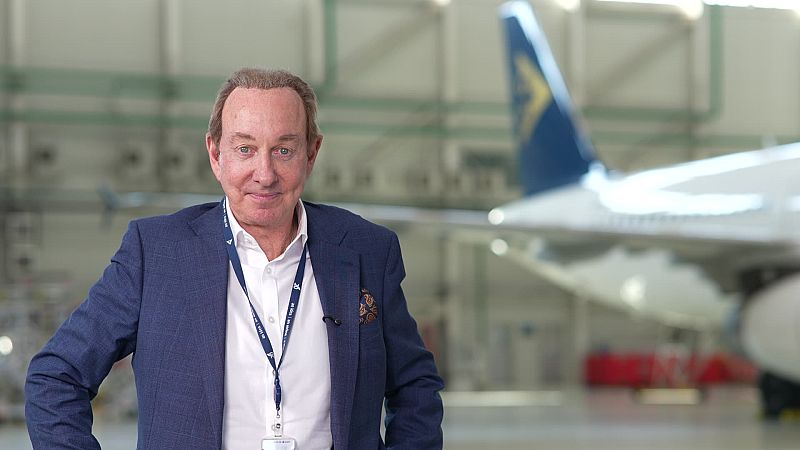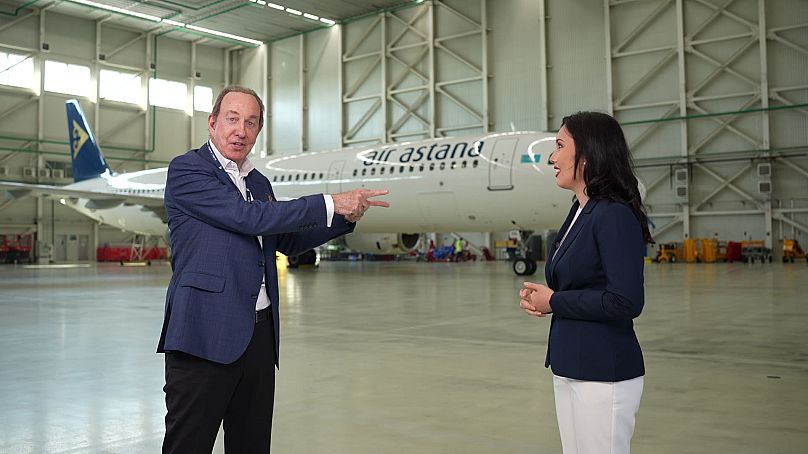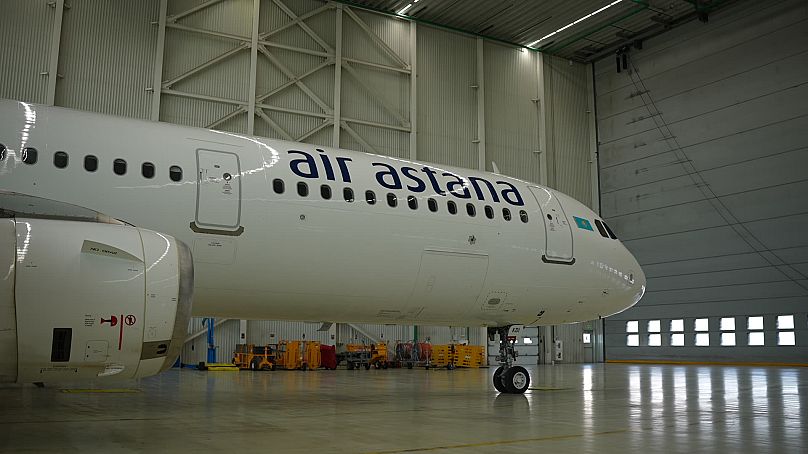
As Central Asia’s only airline listed on three stock exchanges, Kazakhstan’s flagship carrier Air Astana has led the region’s aviation sector for over 20 years.
Since its IPO in February 2024, the airline’s share price has dipped. Ahead of their half year results, Euronews sat down with Air Astana’s CEO, Peter Foster, to discuss his plans to raise share prices and expand Kazakhstan’s flag carrier's global presence.
Q: How do you assess investor sentiment following Air Astana's IPO, and what key strategies do you plan to implement to maintain stock and shareholder value?
A: The stock price has been a bit disappointing since the IPO in February of last year — the stock price has declined. The main point to make is that the company, in fact, has performed extremely well and continues to do so.
So of course, our job is to manage the company to the best of our ability and of course to maximise shareholder value. We have recently announced a very substantial dividend. In fact, the largest dividend that we’ve ever paid, and one of the largest dividends in the airline industry today. And that’s a reflection of the strong performance, of the strong balance sheet, the strong cash balance. We believe that if we continue to manage the company well and if it performs well, the stock price will follow eventually. The key really is to continue managing the airline in the way that we have in all [my] 20 years here: To keep focussed on cost, to keep cost competitive so that the airline remains competitive in an increasingly challenging global marketplace and to maximise service levels to ensure top class safety standards and by doing so, we can leverage the quality of the product to ensure the airline continues being profitable.

Q: You have outlined major strategic opportunities for international growth — in the Gulf, Western Europe, China, Korea, Japan and India. What would these partnerships entail?
A: Kazakhstan is a country of 20 million people and yet Air Astana today is at 62 aircraft and of course we intend to grow that to 84 aircraft by the end of 2028. When you look at the size of Air Astana and growth profile and the overall size of the Kazakhstan market, you see that of course we are proud to serve the Kazakhstan market and Kazakhstan’s travellers, but it’s not sufficient to enable the airline to grow as we are doing into a significant international airline player. Therefore, we absolutely need to leverage our position in close proximity to some of the world’s largest markets to ensure that we are also getting a significant portion of our customers from those large markets which are much bigger than Kazakhstan.
The best way to leverage that geographical position is to work with partner airlines from those countries. We’re presently in discussions with China Southern in China, we are having discussions with carriers in India, we’ve recently signed a code share with Japan Airlines for the Japanese market, we have an existing commercial relationship with Lufthansa for western Europe, with Turkish Airlines for Turkey. So, this is the way that an airline of our aspiration with a home market that is relatively small can leverage the quality of the airline and the geography of location of the airline with partners to expand beyond its own borders.

Q: With the current shortage of fuel-efficient aircraft, how is Air Astana adapting its operational strategies?
A: The manufacturers and the engine manufacturers introduced new engine technology from NASA ten years ago. Without going into technical detail, it was technology that was primarily driven by the need to provide higher bypass engines, which are more fuel-efficient. You get more power from less fuel burned, which saves the airline money and of course, it’s more environmentally sustainable. In fact, on an average flight, it takes to London [from Astana], a 7.5-hour flight, we can save up to 20-25% more fuel than would have been burning in the past times. So that’s very good. The problem with that is that the engine technology is relatively new, complex and it has been subject to reliability issues which are ongoing and so we’re not getting quite the efficiency or the sustainability readings that we had hoped for. But those problems will resolve themselves in time and therefore we can expect to get the full benefits both in terms of economics and the environment as we go forward.
Q: What green technologies or sustainability initiatives is Air Astana adopting to contribute to Kazakhstan’s net-zero goals?
A: We were one of the first movers to bring in the Airbus neo long-range aircraft. In fact, we were the first airline to sign for those aircraft at Paris Air Show ten years ago. They are significantly better, more optimal than the previous engine technology that was deployed on aircraft on those long routes and we will continue to introduce those aircraft in order to meet the sustainability targets.
The manufacturers are working on enhanced technology in terms of aerodynamics, in terms of wing design, in terms of engine design, as we go forward. But inevitably the significant portion of our realisation of net zero will come from carbon credits and the CORSIA scheme (Carbon Offsetting and Reduction Scheme for International Aviation), which has been introduced and endorsed by the United Nations and all member states.







